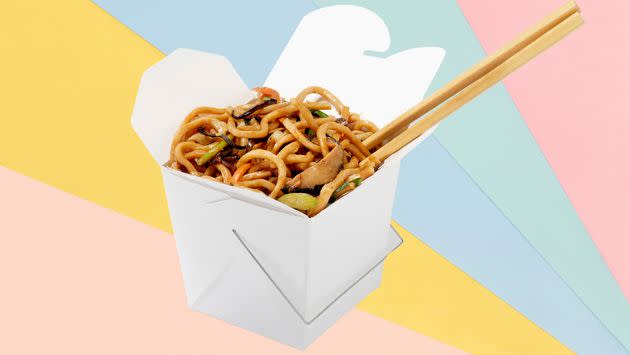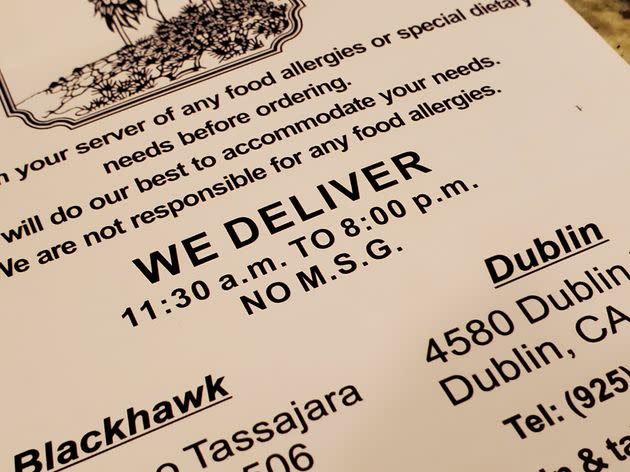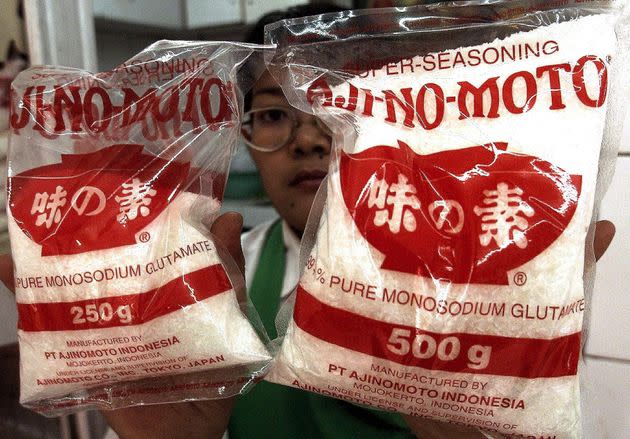Many Americans Have Villainized MSG — And Now It's Making A Comeback

After years of defensively touting “No MSG” on their menus,many Asians working in the food industry are not only fighting back against stereotyping of this heritage ingredient — they’re proudly featuring monosodium glutamate, or MSG, on their menus. If you like to eat authentic Chinese, Japanese, Thai, Vietnamese or Korean food, your taste buds are likely already familiar with MSG, since all those cultures regularly use it in cooking.
MSG is a naturally occurring kind of salt, described scientifically as the “sodium salt of the common amino acid glutamic acid.” It’s present in our bodies and in many glutamate-rich foods like soy sauce, anchovies, tomatoes and cheese.
Chefs use it as a flavor enhancer for both savory and sweet menu items since it provides a punch of pure umami, one of the five tastes that also include sweet, sour, salty and bitter. According to MSG manufacturer Aji-no-moto, umami means “delicious savory taste” in Japanese, and its taste is often described as the meaty, savory quality that deepens flavor. It can also be used as a way to reduce salt in a dish, since MSG contains approximately 12% sodium vs. 40% sodium in salt.
More umami and less sodium? It’s no wonder places like Mission Chinese in San Francisco have put MSG shakers next to the salt and pepper. There’s even one line of hard seltzer, Lunar, which advertises “a pinch of MSG” in some of its drinks.
How Asian chefs feel about the dark ‘No MSG’ days of yore.
“I grew up in an Asian household, and I never knew MSG had such a bad reputation, since my parents always used it,” said Dan Q. Dao, a Vietnamese American food writer. “After learning more about the negative propaganda surrounding it, I was sort of shocked. But in some ways, it’s not all that surprising. After all, in America, Asian food was often stereotyped as cheap and low quality. It took lots of independent research and self-education on my part to understand that the claims made against MSG were rooted in racism.”
Those claims, which Dao correctly noted have been disproved, include reports of weakness, numbness, palpitations and headaches after eating food containing MSG, often Chinese food.
The misconceptions around the ingredient are plentiful. Korean American chefKate Telfeyan pointed out one of the biggest blunders: “People think MSG is chemical, but it’s actually plant-derived.” According to the website for Aji-no-moto, a leading producer of MSG, it’s produced through fermentation of plant-based ingredients including sugar cane, sugar beets, cassava or corn.
But that plant-based origin story hasn’t always been understood or appreciated. “If people don’t want to eat MSG, that’s their choice and prerogative,” said Taiwanese American registered dietitian nutritionist Rebecca Valdez. “I have a greater issue with influencers who use fear, guilt and shame to make people feel they’re not eating ‘clean’ enough, or they’re a bad person for making certain food choices, including foods with MSG.”
Noting that MSG is already used in many packaged foods and in restaurants, Korean American Sean Ro, co-founder of Lunar Hard Seltzer, said, “I don’t see a lot of folks vilifying Chick-fil-A or Doritos for containing MSG — which they absolutely do.”

Japanese American chef John Sugimura, who is preparing to open a new 10-seat sushi bar in Minneapolis’ Eat Street Crossing, commented on the negative stereotyping by putting it simply: “It stings — ’nuff said.”
You can’t be allergic to MSG, but you can be sensitive to it.
How did we get here, anyway? In 1968, The New England Journal of Medicine published a letter titled “Chinese-Restaurant Syndrome,” in which a doctor described symptoms he had after eating Chinese food. He speculated that perhaps MSG, soy sauce or cooking wine could have caused the problem. From that one letter, people seized on the idea that the mysterious ingredient known as MSG was the culprit.
This shaky theory has been disproved but that hasn’t helped dispel the negative associations. The perception continues despite numerous research studies, such as those described by the U.S.Food and Drug Administration: “Although many people identify themselves as sensitive to MSG, in studies with such individuals given MSG or a placebo, scientists have not been able to consistently trigger reactions.”
Tia Rains is a nutrition scientist and vice president of customer engagement and strategic development for the MSG producer Aji-no-moto. She recently told CNN, “When people tell me that they ate at a Chinese food restaurant and they had trouble breathing and tightness in their chest, I get worried — and I’d say, ‘You need to follow up on that because MSG is not an allergen. It’s not going to cause an allergic response. Our bodies make glutamate, so it would not be possible to have an allergy to glutamate.’”
How to use it at home.
Since “salty” and “umami” are two of the five basic tastes, you can see how salt and MSG can complement each other in your home cooking. Taste a little bit of MSG, and you’ll notice that the main flavor is savory, with just a hint of salt. So while you probably won’t want to eliminate salt entirely from recipes, you can introduce that savory boost by combining salt with MSG. Create your own at-home mix of 1 teaspoon finely ground MSG with 2 tablespoons kosher salt, and use it as an all-purpose seasoning wherever you might normally use salt.
You can buy MSG by picking up Ac’cent Flavor Enhancer, which is packaged MSG, at any traditional grocery store. And if you’re shopping at an Asian market, look for the Aji-no-moto brand. Many of the chefs we spoke to recommended it.
“I’m an Aji-no-moto loyalist,” Telfeyan said. “It’s definitely in my top arsenal of go-to seasonings. While too much of it can be overpowering, I think it adds a really savory quality that, when deployed well, can amplify flavors.”

“Adding it judiciously and with an understanding of how much it can alter the flavor of a dish is key to using it properly,” she said. “Like with all seasonings, achieving balance will yield a greater result.”
There are many ways to incorporate MSG into recipes. “It’s truly versatile and all-purpose,” Dao said. “You can add it at various stages of cooking, though it’s best to use while being heated, so it can properly dissolve.”
Ro said his favorite way to use MSG is in soups. “The depth and flavor that MSG adds is clutch for an amateur cook like me,” he said.
“My favorite way to use MSG is to use it when I’m making a veggie sauté dish,” Valdez said. “In many Chinese dishes, we use a bit of meat and fat to add flavor to vegetable dishes, but MSG also works great to enhance flavors and add that umami.”
Prepare yourself for a more open embrace of MSG in the future.
Attitudes about MSG are changing, according to many in the Asian food community. Cookbook author Andrea Nguyen said she didn’t call for any MSG in her first cookbook, “Into the Vietnamese Kitchen,” which was published in 2006. “Even seeing it in a recipe’s ingredient list made some people uncomfortable,” she said. In her latest cookbook, “Ever-Green Vietnamese,” which was published in 2023, recipes call for MSG or an equivalent in Asian mushroom seasoning granules. “I’m encouraging people to play with it. Why let corporations and others determine your MSG experience when you can do it yourself?” she asked.
MSG is turning up in less-expected places, too. Lunar Hard Seltzer teamed up with 886, a New York restaurant named for Taiwan’s international calling code, on a pineapple cakedrink made with a pinch of Aji-no-moto MSG “for that hit of pastry umami,” the brand stated. A collab with Williamsburg’s Cantonese American restaurant Bonnie’s yielded a salted kumquatbeverage, also made with MSG. “Given each of these restaurants’ fight against the xenophobia-rooted vilification of MSG, we all were incredibly proud and excited to create the first-ever hard seltzers with MSG in them,” Ro said.
A similar shift is emerging in the restaurant scene, chefs said. “The narrative and negative connotation MSG had is definitely changing with the younger generation, and there are more and more people like me who are proudly using it and advertising that we’re using it,” said Calvin Eng, the Chinese American owner and chef at Bonnie’s, which created that hard seltzer flavor with Lunar. Eng’s cookbook, “Salt, Sugar + MSG,” is slated for publication in March of next year.
“I use MSG not only in savory dishes, but in desserts and drinks, too,” he said. Eng calls on MSG as a workhorse in his busy kitchen, including dissolving it in water as a vegetable blanch for his Garlic-Chive Ranch Dip with Crudités. “We even put it in the name of menu items, like our MSG Martini.”
For many Asian American and Pacific Islander food professionals, accepting MSG in their work also can contribute to greater self-acceptance. “For many years, I had a sense of cultural limbo that characterized my life,” Sugimura said. “When I became a fully trained Japanese chef, I began to see my world open up. Asian cuisine delivers a story that certainly resonates not just with me, but with those who want to eat with purpose and meaning. Some foods are deserving of an MSG bump — so deal with it, people.”

